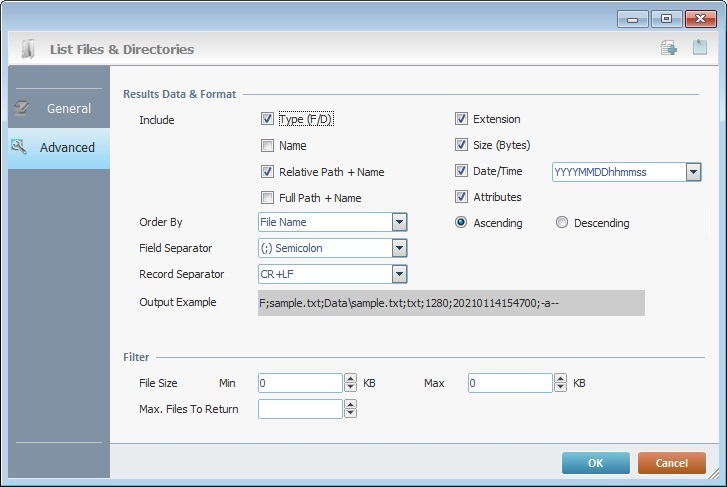Working with List Files & Directories Process
Process Purpose
The "List Files & Directories" process is used to create a list of the files and/or directories contained in a specific device folder. This list can be stored in a file or variable.
When you add a process, you are required to define its settings. This occurs in the process's properties window which is displayed automatically after having added the "List Files & Directories" process. In this case, the properties window includes two tabs - "General" and "Advanced".
If any subsequent edition is required, double-click the process to open its properties window and enter the necessary modifications.
"General" Tab

Fill in the following options:
Search For |
|||||||
Files |
Define the entity/entities to be listed by checking the corresponding box - Files and/or Directories (folders included in the destination folder). |
||||||
Directories |
|||||||
Mask |
Define the pattern that will be used to return the files/directories for your list OR click
|
||||||
Search In |
|||||||
Folder |
Define the location of the files/directories to search for so the list can be created. Select one of the locations available in the drop-down ("<DATA>"; "<RES>"; "<SHARED>"; "<EXTDATA>"; or "<EXTSHARED>") OR click
"<DATA>"; "<RES>"; "<SHARED>" are aliases for MCL folders within the device. See Working with Aliases for more details. "<EXTDATA>"; or "<EXTSHARED>" are aliases that refer to locations outside the MCL environment. |
||||||
Include Subdirectories |
If required, check this option so the search for the intended files includes the existing subdirectories. |
||||||
Results |
|||||||
Destination |
Define the type of element that will store the resulting list - check "Variable" or "File". The following option relates to the destination type you selected previously:
|
||||||
Number of Files |
Click |
||||||
Total Size (Bytes) |
Click |
||||||
Proceed to the "Advanced" tab.
"Advanced" Tab

Fill in the following options:
Results Data & Format |
|
Include |
Check the information/characteristics you want to view regarding each listed file.
If "Date/Time" is checked, select the intended output format from the drop-down. |
Order By |
Define which of the attributes available in the drop-down will be used to base the sorting of the list on ("File Name"; "File Extension"; "File Date/Time" or "File Size").
Define the sorting order of the file list by checking "Ascending" OR "Descending". |
Field Separator |
Select the field separator to be used to separate the previously defined information/characteristics. |
Record Separator |
Select the record separator from the drop-down. |
Output Example |
This section provides an output preview that is the result of your data and format choices in this tab. |
Filter |
|
File Size |
Define the minimum and maximum sizes (in KB) for the files to be listed. Ex: If you define 12 KB as a minimum value and 35 KB as maximum value, the list will include all the files in the intended folder that have a size of, at least, 12 KB up to 35 KB.
If the "Min" and "Max" options are left blank, all the files in the selected target folder will be listed regardless of their size. If necessary, you can use up to 3 decimal places to define a minimum/maximum value. Ex: Defining a max value of "0.800 KB" means that the list can only include files with a maximum size of 102.400 Bytes. |
Max. Files to Return |
Define the maximum number of files to be listed.
If the option is left blank, all the files of the target folder that meet the defined filter criteria will be listed. |
If required, use the icons on the upper right corner of the process properties window:
![]() Click this icon to create a new data file. Go to Creating a Data File to see how to fill in the several options available.
Click this icon to create a new data file. Go to Creating a Data File to see how to fill in the several options available.
![]() Use the icon to attach any relevant notes to this process. Click it and enter your notes in the resulting text box. These notes will be displayed in the corresponding "Actions" tab or "Process" window (in the "Notes" field) and in the "Developer Report".
Use the icon to attach any relevant notes to this process. Click it and enter your notes in the resulting text box. These notes will be displayed in the corresponding "Actions" tab or "Process" window (in the "Notes" field) and in the "Developer Report".
Click ![]() to conclude and apply the choices made in both tabs or select
to conclude and apply the choices made in both tabs or select ![]() to abort the operation.
to abort the operation.
The added process is displayed in the corresponding "Actions" tab or "Process" window.
![]()
Use the right-click in MCL-Designer's input boxes to access some related options as well as the general "Cut", "Copy"; "Paste"; "Search" actions (active/inactive according to the current context).
Ex: If you right-click the "Variable" input box (included in a "Conversion's" properties window), you are provided with general editing/search actions and other more specific options such as "Variable Select" (see "Variable Select"); "Variable Insert" (see "Variable Insert"); "Insert Special Character" (see To Insert Special Characters into a Control's Text Input Field) and "Localization Select" (see Localization List).
If you right-click another input box, it may provide other possibilities.
